Sea Trout Fishery Statistics - 2011 Season
Sea trout fishery statistics - rod and net catch together with net fishing effort based on returns from proprietors/occupiers/agents of sea trout fisheries throughout Scotland for the 2011 season
// SUMMARY
For Scotland as a whole, total reported rod catch of sea trout (retained and released) for 2011 was 23,324. Catches have declined over much of the period since 1952, when our records began. Although increasing by 4% compared to the previous 5-year average, total reported rod catch in 2011 was the sixth lowest in the 60 year time series.
The proportion of the total rod catch accounted for by catch and release has shown a general increase since records began in 1994 and accounted for 70% of the catch in 2011.
There are clear differences among geographic regions in the relative strength of the 2011 rod catch. All mainland regions in the west of Scotland reported catches which were within the lowest five recorded over the period 1952 to 2011. The reported catch in Moray Firth and North East regions were, similarly, the second and eighth lowest respectively over the same period. Catches in the East and North regions in 2011 were, on the other hand, both among the top two catches recorded within their respective regions, while the catch recorded in the Outer Hebrides was close to the mid-point in the time series.
Catch and effort for both fixed engine and net & coble fisheries remain at historically low levels. Reported catch in each fishery was 1,758 and 3,890; 3% and 2% of the maximum reported in the respective time series. Fishing effort in these fisheries was 194.5 trap months and 80 crew months; the fourth and fifth lowest, respectively, since records began in 1952.
The information presented here are a summary of the data from 1,848 forms returned from 2,001 issued (92% return rate) for the 2011 season. Return rates for the previous 10 years have been between 93% and 96%.
Current status of stocks
Since 2003, rod catches of sea trout for Scotland as a whole have been among the lowest in the time-series. Although catches have shown a slight increase since 2008, they remain at historically low levels.
There are clear differences among geographic regions in the relative strength of the 2011 rod catch. Catches in all mainland regions in the west of Scotland together with the Moray Firth and North East regions are at historically low levels, while catches in the East and North Regions are both among the highest catches recorded within their respective regions over the last 60 years. The catch recorded in the Outer Hebrides was close to the mid-point of the time series for that region.
Further, the status of stocks on smaller geographical scales ( e.g. among or within catchments) may differ both from each other and also from the overall assessments presented above.
// CATCH AND EFFORT REPORTED BY SCOTTISH FISHERIES IN 2011
The rod and line fishery
7,069 sea trout were reported caught and retained in the rod and line fishery. A further 16,255 sea trout were reported caught and released. We have no comprehensive time series of fishing effort information associated with the rod and line fishery.
Total rod catches (retained and released) of sea trout for Scotland as a whole have declined over much of the period since 1952, when our records began. Although catches have shown a slight increase since 2008, total reported rod catch in 2011 was the sixth lowest in the 60 year time series (Figure 1).
Finnock are sea trout which have spent only a few months at sea before making their first return to fresh water. They may also be known as whitling or herling. Finnock catches have been reported since 2004. The total rod catch of finnock in 2011 was 7,135 which was 97% of the previous 5-year average (Figure 1).
Catch and release
The proportion of the rod catch accounted for by catch and release has shown a general increase since 1994, when catch and release information was first recorded (Figure 2) and accounted for 70% of the total rod catch in 2011. 82% of finnock taken by the rod fishery were subsequently released in 2011.
Figure 1 Rod and line fishery.
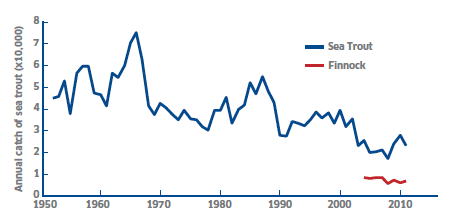
Figure 2 Catch and release, rod and line fishery.
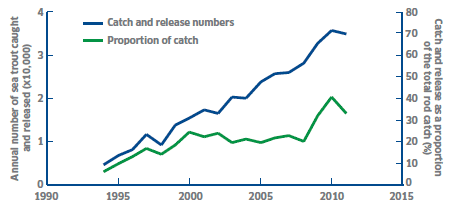
Comparison of catches among geographic regions
Analysing the catch data at finer geographical scales reveals differences among regions in the relative strength of 2011 catches compared to available historical data. Annual reported rod catch (retained and released) for each region was ranked over the time series from 1952 to the present (1=lowest, 60=highest). Thus, a rank value of 1 would indicate that the catch for that year was the lowest recorded in the time series for that region, while a value of 60 would indicate a region's highest recorded catch.
Figure 3 Relative strength of 2011 rod catch among regions
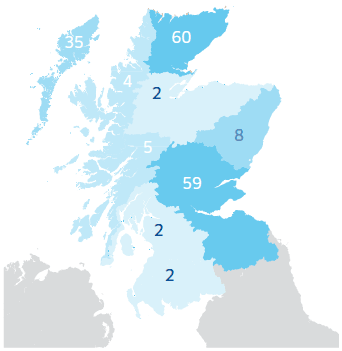
The values for the 2011 catch in each region are shown in Figure 3. Colours also reflect these ranking values for the regions (shading from lightest to darkest indicate ranking values from lowest to highest). Orkney and Shetland have been omitted from this regional analysis as they are not considered to have been fully covered by the survey over much of the time series.
All mainland regions in the west of Scotland reported catches for 2011 which were within the lowest five recorded over the period 1952 to 2011. The reported catch in Moray Firth region was, similarly, the second lowest over the last 60 years. Catches in the East and North regions in 2011 were, on the other hand, both among the top two catches recorded within their respective regions over the same period. The 2011 catch in the North East region was the eighth lowest over the last 60 years, while the catch recorded in the Outer Hebrides was close to the mid-point in the time series.
The net fisheries
1,758 sea trout were reported caught and retained in the fixed engine fishery. The national index of fishing effort was 194.5 trap months. 3,890 sea trout were reported caught and retained in the net & coble fishery, and the reported effort was 80 crew months.
Reported catch and effort in both net fisheries have declined over much of the period covered by our records and remain at historically low levels (Figures 4 & 5). In 2011, fishing effort in the fixed engine and net & coble fisheries was the fourth and fifth lowest, respectively, since records began in 1952. Reported catch in each fishery was 3% and 2% of the maximum reported in the respective time series.
Figure 4 Fixed engine fishery.
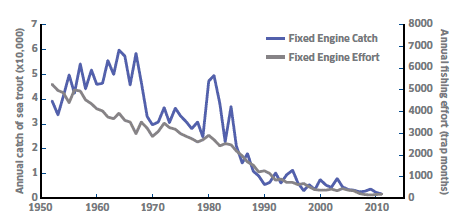
Figure 5 Net and coble fishery.
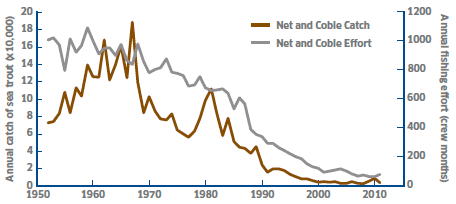
// INTERPRETATION
Recent events
Reported sea trout catches for Scotland as a whole have shown a slight increase since 2008 but remain at historically low levels. This may indicate low numbers of fish both entering fresh water and escaping to spawn.
Year on year changes in catch are not a simple reflection of changes in the underlying numbers of fish returning to Scottish waters. Both catch size and the allocation of catch among fishing methods may be influenced by many factors, most obvious of which are often related to fishing effort or environmental factors. Thus, when inferring the status of stocks from catch data, it is important to consider trends over a number of years as well as focussing on catch levels for the most recent years.
The decline in net fisheries
Both the fixed engine and net & coble fisheries show a substantial decline in catch over the period for which there are data. A major factor in the overall decline has been the long term decrease in the size of the netting industry, indicated in these statistics by the decline in reported effort. This decline has been largely driven by changes in the salmon netting industry, as in the vast majority of cases salmon is the primary target species for these fisheries.
Relative strength of rod catch varies among geographic regions
There are clear differences among geographic regions in the relative strength of the 2011 rod catch compared to previous years (see Figure 3).
The data indicates no simple east v. west difference. Rod catches in all mainland regions in the west of Scotland together with the Moray Firth and North East regions are at historically low levels, while catches in the East and North Regions are both among the highest catches recorded within their respective regions over the last 60 years. The catch recorded in the Outer Hebrides was close to the mid-point of the time series for that region.
Trends in rod catch may be taken to infer trends in spawning
Our best interpretation of sea trout stocks is derived from the reported catch figures, detailed in this topic sheet. Although our lack of information on rod fishing effort and effectiveness weakens our ability to make inference from catch trends, the observation that rod catches in a given area are at historically low levels nevertheless suggests current levels of spawning escapement of sea trout may be at similarly poor levels.
Downloads
Topic sheet no. 67 explains how we collect the catch statistics
and is available for download at
http://www.scotland.gov.uk/Topics/marine/science/Publications/TopicSheets/tslist
Summary data for the 2011 fishing season are available for
download at
http://www.scotland.gov.uk/Topics/marine/science/Publications/stats/SalmonSeaTroutCatches
The data provided for download are the best available at the time of publication. Our records are amended when further information is provided and the most accurate historical data may be obtained directly from us.
Contact
If you have a specific request for Scottish salmon and sea trout fishery information, please contact us directly at ms.catchform@scotland.gsi.gov.uk
Contact
There is a problem
Thanks for your feedback